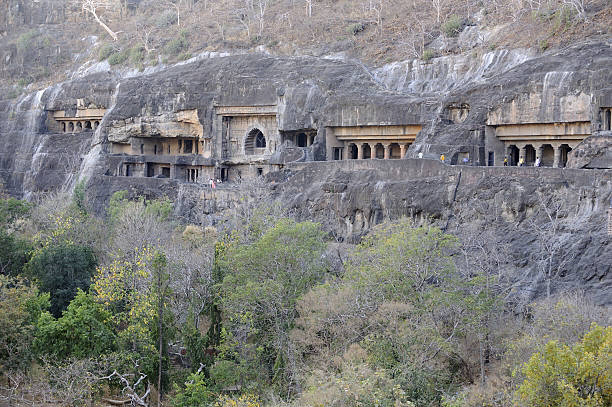The Ajanta and Ellora caves are two of the most famous rock-cut cave complexes in India. They are located in the state of Maharashtra, about 100 kilometers apart. The Ajanta caves are Buddhist caves, while the Ellora caves are a mix of Hindu, Jain, and Buddhist caves.
The Ajanta caves were built over a period of about 500 years, from the 2nd century BCE to the 7th century CE. They are famous for their beautiful paintings, which depict scenes from the life of the Buddha and other Buddhist stories. The paintings are still in remarkably good condition, and they are considered to be some of the finest examples of ancient Indian art.
The Ellora caves were built over a period of about 400 years, from the 6th century CE to the 10th century CE. They are more varied than the Ajanta caves, and they include monasteries, temples, and halls. The Hindu caves are the most numerous, but there are also significant Jain and Buddhist caves. The Ellora caves are famous for their sculpture, which is some of the finest in India.
Both the Ajanta and Ellora caves are UNESCO World Heritage Sites. They are a testament to the artistic and architectural achievements of ancient India, and they continue to attract visitors from all over the world.
THE AJANTA CAVES
The Ajanta caves are located in a horseshoe-shaped gorge on the Waghora River in Maharashtra, India. There are 29 caves in the complex, all of which were carved out of a single cliff face. The caves were built over a period of about 500 years, from the 2nd century BCE to the 7th century CE.
The Ajanta caves are divided into two groups: the monastic caves and the chaitya caves. The monastic caves were used as living quarters and meditation halls for Buddhist monks. They typically have a veranda, a central courtyard, and a number of rooms. The chaitya caves are prayer halls, and they are characterized by a long hall with a curved roof that resembles a cave. The walls of the chaitya caves are decorated with paintings and sculptures depicting scenes from the life of the Buddha.
The paintings in the Ajanta caves are some of the finest examples of ancient Indian art. They arep still in remarkably good condition, and they provide a vivid glimpse into the life and culture of ancient India. The paintings depict a wide range of subjects, including stories from the life of the Buddha, religious ceremonies, and everyday life. The paintings are also notable for their use of color, their attention to detail, and their graceful composition.
The Ajanta caves were abandoned in the 7th century CE, and they were rediscovered in 1819 by a British officer named John Smith. The caves were quickly recognized as a major archaeological site, and they have been the subject of extensive study and conservation efforts ever since.
THE ELLORA CAVES
The Ellora caves are located about 100 kilometers from the Ajanta caves. There are 34 caves in the complex, and they were built over a period of about 400 years, from the 6th century CE to the 10th century CE. The Ellora caves are more varied than the Ajanta caves, and they include monasteries, temples, and halls. The Hindu caves are the most numerous, but there are also significant Jain and Buddhist caves.
The Hindu caves at Ellora are some of the largest and most impressive rock-cut temples in India. They are dedicated to a variety of Hindu deities, including Shiva, Vishnu, and Brahma. The temples are decorated with elaborate sculptures, which depict scenes from Hindu mythology.
The Jain caves at Ellora are smaller than the Hindu caves, but they are no less impressive. They are dedicated to the Jain tirthankaras, or saviors. The caves are decorated with beautiful sculptures, which depict scenes from the lives of the tirthankaras.
The Buddhist caves at Ellora are the smallest of the three groups of caves. They are dedicated to the Buddha and other Buddhist figures. The caves are decorated with paintings and sculptures, which depict scenes from the life of the Buddha and other Buddhist stories.
The Ellora caves are a UNESCO World Heritage Site. They are a testament to the artistic and architectural achievements of ancient India, and they continue to attract visitors from all over the world.
The Difference Between Ajanta and Ellora Caves
The Ajanta and Ellora caves are two of the most famous rock-cut cave complexes in India, but they have a number of important differences.
The Ajanta caves are all Buddhist, while the Ellora caves are a mix of Hindu, Jain, and Buddhist caves.
Time period: The Ajanta caves were built over a period of about 500 years
अजंता - एलोरा नही देखा तो कुछ नही देखा।












No comments:
Post a Comment